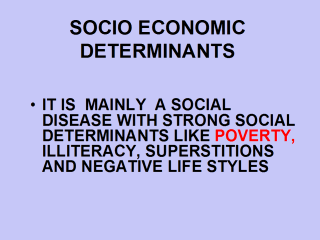| front |1 |2 |3 |4 |5 |6 |7 |8 |9 |10 |11 |12 |13 |14 |15 |16 |17 |18 |19 |20 |21 |22 |23 |24 |25 |26 |27 |28 |29 |30 |31 |32 |33 |34 |35 |36 |37 |38 |39 |40 |41 |42 |review |
 |
India is a large
country with varied populations, cultures, beliefs and socio-economic status
across the country. TB as a disease and its treatment may be viewed
differently in the various socio-cultural-economic conditions prevailing in
India today. Thus regional and culturally-specific strategies to provide
DOTS need to be developed and implemented. POVERTY COMPLEX POVERTY (DISEASE Z) - DOTS strategy is, no doubt, very effective technique but only when administered properly. Is our patient correct fit for it? Let us be realistic and think in Indian context. Tuberculosis in India is predominantly a poor man's disease. Poverty itself is a serious disease (disease z). Illiteracy and ignorance thrive on poverty. Let us once visualize, for treatment sake at least, our unfortunate, poor, illiterate, thin, malnourished Tb patient with a large family, living in an overcrowded slum, rural or tribal area very far from any health facility. How to make both of them fit to each other for better compliance? IT IS A REAL QUESTION |